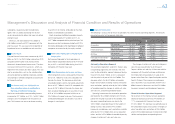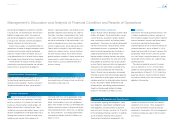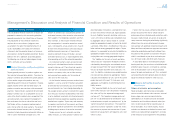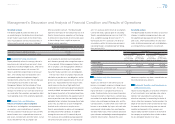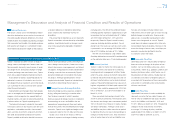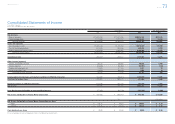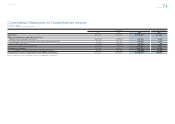Toyota 2013 Annual Report Download - page 69
Download and view the complete annual report
Please find page 69 of the 2013 Toyota annual report below. You can navigate through the pages in the report by either clicking on the pages listed below, or by using the keyword search tool below to find specific information within the annual report.
Toyota Global Vision President’s Message Launching a New Structure Special Feature Review of Operations
Consolidated Performance
Highlights
Management and
Corporate Information Investor InformationFinancial Section
Page 69
NextPrev
ContentsSearchPrint
ANNUAL REPORT 2013
of fi nance, trade and other receivables. Toyota
determines the allowance for doubtful accounts and
credit losses based on a systematic, ongoing review
and evaluation performed as part of the credit-risk
evaluation process, historical loss experience, the
size and composition of the portfolios, current eco-
nomic events and conditions, the estimated fair
value and adequacy of collateral, and other perti-
nent factors. This evaluation is inherently judgmental
and requires material estimates, including the
amounts and timing of future cash fl ows expected
to be received, which may be susceptible to signifi -
cant change. Although management considers the
allowance for doubtful accounts and credit losses to
be adequate based on information currently avail-
able, additional provisions may be necessary due to
(i) changes in management estimates and assump-
tions about asset impairments, (ii) information that
indicates changes in expected future cash fl ows, or
(iii) changes in economic and other events and
conditions. To the extent that sales incentives
remain an integral part of sales promotion with the
effect of reducing new vehicle prices, resale prices
of used vehicles and, correspondingly, the collateral
value of Toyota’s retail receivables and fi nance lease
receivables could experience further downward
pressure. If these factors require a signifi cant
increase in Toyota’s allowance for doubtful accounts
and credit losses, it could negatively affect future
operating results of the fi nancial services operations.
The level of credit losses, which has a greater
impact on Toyota’s results of operations, is
infl uenced by two factors: frequency of occurrence
and expected severity of loss. For evaluation pur-
poses, exposures to credit losses are segmented
into the two primary categories of “consumer” and
“dealer”. Toyota’s “consumer” category consists of
smaller balances that are homogenous retail receiv-
ables and fi nance lease receivables. The “dealer”
category consists of wholesale and other dealer
loan receivables. The overall allowance for credit
losses is evaluated at least quarterly, considering a
variety of assumptions and factors to determine
whether reserves are considered adequate to cover
probable losses.
Sensitivity analysis
The level of credit losses, which could signifi cantly
impact Toyota’s results of operations, is infl uenced
by two factors: frequency of occurrence and
expected severity of loss. The overall allowance for
credit losses is evaluated at least quarterly, consid-
ering a variety of assumptions and factors to
determine whether reserves are considered ade-
quate to cover probable losses. The following table
illustrates the effect of an assumed change in fre-
quency of occurrence or expected severity of loss
mainly in the United States, assuming all other
assumptions are held consistent respectively. The
table below represents the impact on the allowance
for credit losses in Toyota’s fi nancial services opera-
tions of the change in frequency of occurrence or
expected severity of loss as any change impacts
most signifi cantly on the fi nancial services operations.
Management’s Discussion and Analysis of Financial Condition and Results of Operations
Yen in millions
Effect on the allowance for credit
losses as of March 31, 2013
10 percent change in frequency of occurrence or expected severity of loss ¥3,950
Investment in Operating Leases
Natures of estimates and assumptions
Vehicles on operating leases, where Toyota is the
lessor, are valued at cost and depreciated over their
estimated useful lives using the straight-line method
to their estimated residual values. Toyota utilizes
industry published information and its own historical
experience to determine estimated residual values
for these vehicles. Toyota evaluates the recoverabili-
ty of the carrying values of its leased vehicles for
impairment when there are indications of declines in
residual values, and if impaired, Toyota recognizes
an allowance for losses on its residual values.
Throughout the life of the lease, management
performs periodic evaluations of estimated end-of-
term fair values to determine whether estimates
used in the determination of the contractual residual
value are still considered reasonable. Factors affect-
ing the estimated residual value at lease maturity
include, but are not limited to, new vehicle incentive
programs, new vehicle pricing, used vehicle supply,
projected vehicle return rates, and projected loss
severity. The vehicle return rate represents the num-
ber of leased vehicles actually returned at contract
maturity as a percentage of the number of lease
contracts originally scheduled to be mature in the
same period less lease contracts subject to early
terminations. A higher rate of vehicle returns
exposes Toyota to higher potential losses incurred
at lease termination. Severity of loss is the extent to
which the end-of-term fair value of a lease is less
than its carrying value at lease end.
To the extent that sales incentives remain an inte-
gral part of sales promotion, resale prices of used
vehicles and, correspondingly, the fair value of
Toyota’s leased vehicles could be subject to down-
ward pressure. The extent of the impact this will
have on the end of term residual value depends on
the signifi cance of the incentive programs and
whether they are sustained over a number of peri-
ods. This in turn can impact the projection of future
used vehicle values, adversely impacting the
expected residual value of the current operating
lease portfolio and increasing the provision for resid-
ual value losses. However, various other factors
impact used vehicle values and the projection of
future residual values, including the supply of and
demand for used vehicles, interest rates, infl ation,
the actual or perceived quality, safety and reliability
of vehicles, the general economic outlook, new
vehicle pricing, projected vehicle return rates and
projected loss severity, which may offset this effect.
Such factors might adversely affect the results of
operations for fi nancial services due to signifi cant
charges reducing the estimated residual value.
Selected Financial Summary (U.S. GAAP) Consolidated Segment Information Consolidated Quarterly Financial Summary Management’s Discussion and Analysis of Financial Condition and Results of Operations [24 of 26] Consolidated Financial Statements Notes to Consolidated Financial Statements
Management’s Annual Report on Internal Control over Financial Reporting Report of Independent Registered Public Accounting Firm





